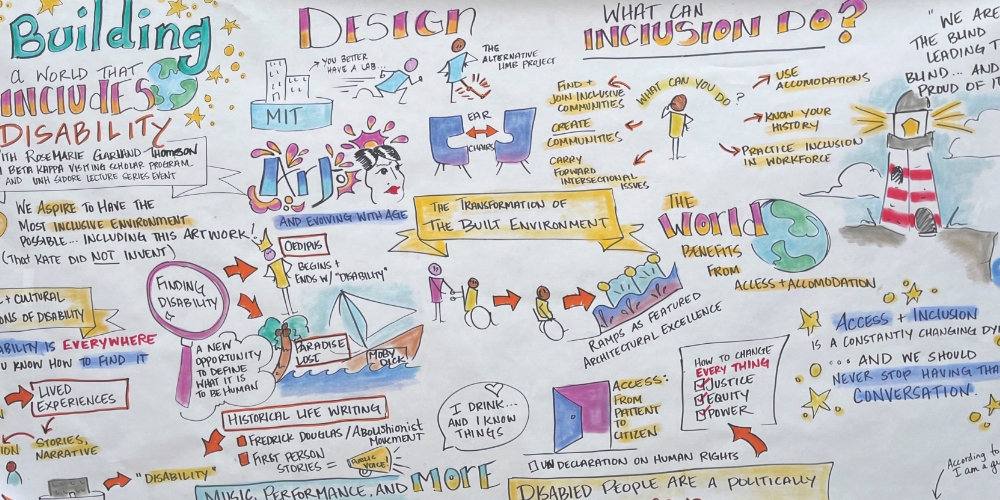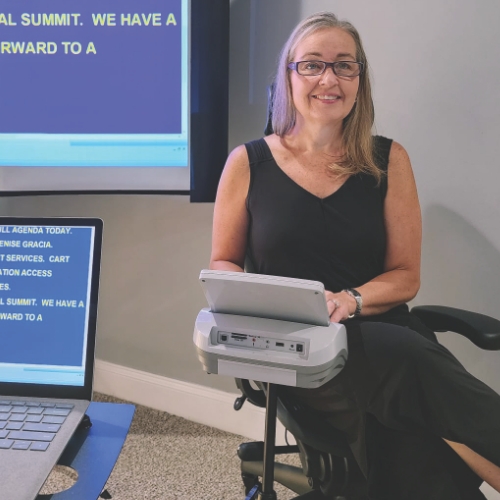 Registering for a conference, attendees may find an option on the website’s registration page to request an accommodation and for those who are deaf that often means having an American Sign Language (ASL) interpreter on stage.
Registering for a conference, attendees may find an option on the website’s registration page to request an accommodation and for those who are deaf that often means having an American Sign Language (ASL) interpreter on stage.
However, that is only one option for making sure meetings are accessible for all, including those who are deaf or hard of hearing. There may be several people in an audience who have a degree of hearing loss who may not consider themselves in need of such an accommodation, or who do not know sign language, but who may have difficulty fully following presentations.
A recent report from the World Health Organization (WHO) projects that by 2050 nearly 2.5 billion people will have some degree of hearing loss and at least 700 million will require hearing rehabilitation. The prevalence of hearing loss increases with age. Among those older than 60 years, over 25% are affected by disabling hearing loss, according to WHO. New Hampshire is the second-oldest state in the nation, with a median age of 43.1, and 18.7% of residents are 65 and older, compared with 16.5% nationwide, according to the Carsey School of Public Policy at the University of NH.
When people have a hard time hearing, the brain works hard to comprehend what is being said and to fill in the gaps. If a presentation is interactive or includes a question and answer period, those with hearing issues may be reluctant to participate not knowing what they may have missed.
There are other options available to enhance the meeting experience and meet the needs of those who are deaf or have experienced hearing loss, including Communication Access Realtime Translation (CART), which provides live captioning of what is being said in a meeting or presentation, and graphic recording, where an artist captures in images the themes being discussed.

“When we are more inclusive, people are more driven to contribute,” says Kate Crary (Katemakesthings.com), an artist, graphic recorder and project director for the Institute of Health Policy and Practice and its Center on Aging and Community Living at the University of NH in Durham. She says including such services at a meeting addresses those invisible challenges people experience that interfere with their ability to fully participate.
However, many meeting organizers do not provide such services unless it is specifically requested. “It’s often assumed accessibility or accommodation is not needed unless it is requested,” says Denise Gracia, an independent freelance CART captioner. “At the time of registration, [the website] might say, ‘if you need ASL or CART services, let us know.’”
Gracia says there are some meeting organizers and organizations that automatically provide CART services at their meetings and events and advertise it. “If more organizations made it a best practice, the gold standard as it benefits many populations, we would be better off,” she says. “It shows the event is all inclusive and everyone matters.”
Graphic Recording
While many people are familiar with captioning (a Google search will bring up plenty of articles about the rising popularity of watching shows and movies with captioning or subtitles, especially among younger people), they may not be as familiar with graphic recording.
“Graphic recording is the art of live mural making,” Crary says. “Typically, an artist, like myself, trained in really active listening, comes to a meeting or panel presentation listening, closely to the content and extrapolates themes, creating a mural of those [themes] in live time for the participants.”
Crary says she provides graphic recording at live and virtual events, and it can be used for just about any meeting format, from panel discussions and lectures to strategic planning meetings. The cost for a graphic recorder can vary depending on the type and length of a meeting or event, though Crary says her day rate is approximately $2,000.
“It uses primarily icons—universally understood images,” she says, explaining people often use metaphors when communicating, and graphic recording offers a unique visual way of capturing stories, metaphors and themes.
And it is a tool that allows people to digest information differently and in a way that may be more palatable to them than just listening or reading what is being said. “People are really starting to honor we all have different [ways of] learning,” Crary says. “Graphic recording keys into those different learning preferences.”
For individuals who have a hearing disability, a screen reader may not effectively capture metaphors, anecdotal stories or jokes that can be captured visually through graphic recording, Crary says.
It can also help people be more open when discussing sensitive or difficult topics, she says, citing a meeting for the NH chapter of the National Alliance on Mental Illness about five years ago. “There were a number of really challenging and important discussions that happened—people sharing stories of difficulties that affected their mental health and trauma stories,” she says, explaining that having those stories also communicated in drawing helped to alleviate the stress for some storytellers because they were not the sole focus of attention while speaking. “I was able to capture the story in a way that honored the person telling the story and create community,” as she, the storyteller and the audience were creating art together, Crary says. “When we create art together, it fosters inclusivity and coming together to find common ground.”
Another advantage of graphic recording is it creates another record of the meeting or event that organizers can keep and refer to. Clients have even asked Crary to create digital icons from her murals to use online.
CART/Captioning
As mentioned previously in the article, there has been an increase in the popularity of people using captioning subtitles when watching streaming services. According to a June 6 article in The Atlantic, a full two-thirds of Roku’s millennial customers use subtitles, more than any other generation. The article also points out that “subtitles serve an important purpose for people with hearing or cognitive impairments….”
The use of CART services to provide live captioning of meetings has been around for years, but it still is not ubiquitous.

Denise Gracia is a trained stenographer and a freelance CART captioner who is hired to take what is being said at a meeting or event and turn it into text in real time, which is then projected onto a screen for in-person meetings or accessed via a link for those in virtual meetings. Meeting organizers can also request a transcript of their event.
“It can be used in all environments. I have captioned funerals and weddings, health appointments,” in addition to meetings and events, says Gracia. “When you provide this service, it improves engagement and overall comprehension. It helps people who are deaf and hard of hearing, people with cognitive issues or people on the spectrum,” Gracia says.
Gracia says she often works in tandem with ASL interpreters but says captioning is a more universal tool as some people may have hearing difficulties but not know ASL. “It is equal experience and access for everyone,” she says.
Gracia says fees for caption services can run between $95 and $115 per hour but could include other fees if the captioner is also providing a projector and screen as well as for travel.
And while some meeting providers rely on automatic speech software (ASR) to provide captioning, she says there are limitations to that technology. As anyone using ASR captioning for online videos knows, such software can misinterpret words or incorrectly interpret someone who has an accent. “We [CART providers] can filter out some of the junk words—the ‘ums’ and ‘ahs’ or false starts, which makes it easier for readability for the people who are really dependent on it,” Gracia says. “[People] think [ASR] is good enough, but good enough isn’t equal access,” Gracia says.
This story was originally produced by Granite Media Group for the 2023 edition of Stepping Stones NH, a publication of NH Council on Developmental Disabilities.
